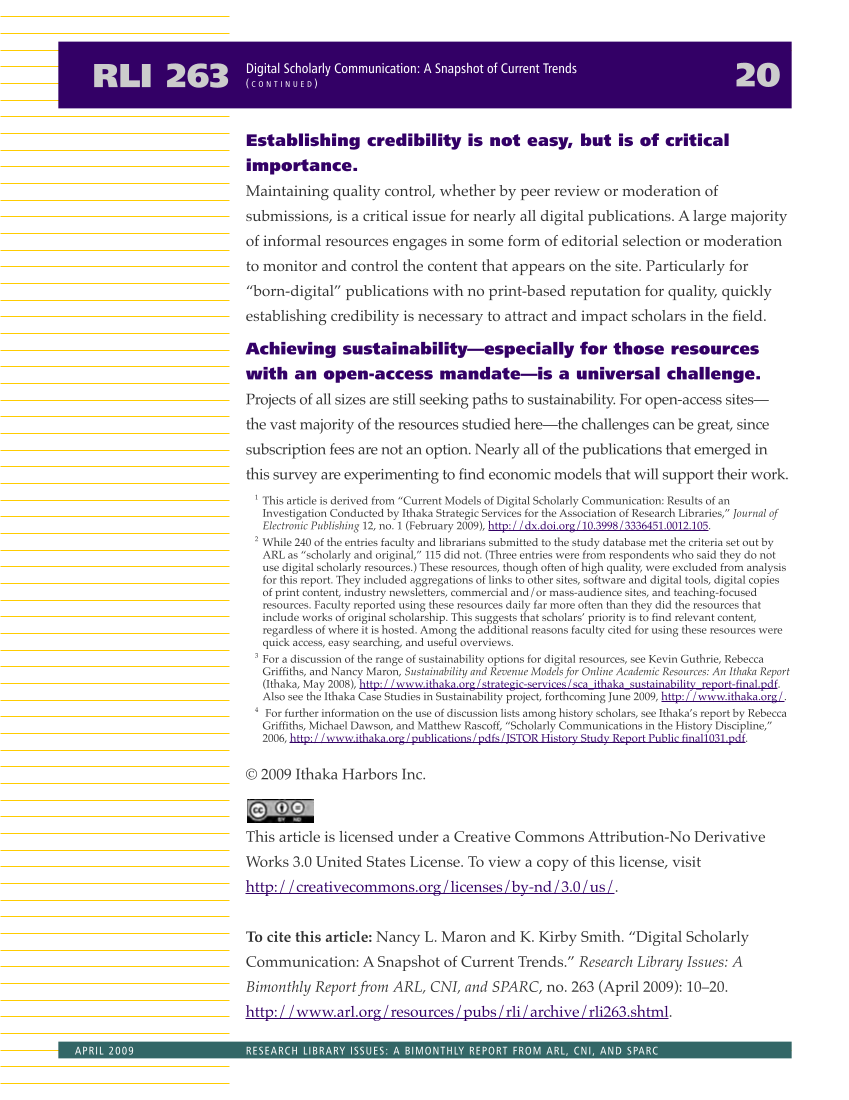Establishing credibility is not easy, but is of critical importance. Maintaining quality control, whether by peer review or moderation of submissions, is a critical issue for nearly all digital publications. A large majority of informal resources engages in some form of editorial selection or moderation to monitor and control the content that appears on the site. Particularly for “born-digital” publications with no print-based reputation for quality, quickly establishing credibility is necessary to attract and impact scholars in the field. Achieving sustainability—especially for those resources with an open-access mandate—is a universal challenge. Projects of all sizes are still seeking paths to sustainability. For open-access sites— the vast majority of the resources studied here—the challenges can be great, since subscription fees are not an option. Nearly all of the publications that emerged in this survey are experimenting to find economic models that will support their work. 1 This article is derived from “Current Models of Digital Scholarly Communication: Results of an Investigation Conducted by Ithaka Strategic Services for the Association of Research Libraries,” Journal of Electronic Publishing 12, no. 1 (February 2009), http://dx.doi.org/10.3998/3336451.0012.105. 2 While 240 of the entries faculty and librarians submitted to the study database met the criteria set out by ARL as “scholarly and original,” 115 did not. (Three entries were from respondents who said they do not use digital scholarly resources.) These resources, though often of high quality, were excluded from analysis for this report. They included aggregations of links to other sites, software and digital tools, digital copies of print content, industry newsletters, commercial and/or mass-audience sites, and teaching-focused resources. Faculty reported using these resources daily far more often than they did the resources that include works of original scholarship. This suggests that scholars’ priority is to find relevant content, regardless of where it is hosted. Among the additional reasons faculty cited for using these resources were quick access, easy searching, and useful overviews. 3 For a discussion of the range of sustainability options for digital resources, see Kevin Guthrie, Rebecca Griffiths, and Nancy Maron, Sustainability and Revenue Models for Online Academic Resources: An Ithaka Report (Ithaka, May 2008), http://www.ithaka.org/strategic-services/sca_ithaka_sustainability_report-final.pdf. Also see the Ithaka Case Studies in Sustainability project, forthcoming June 2009, http://www.ithaka.org/. 4 For further information on the use of discussion lists among history scholars, see Ithaka’s report by Rebecca Griffiths, Michael Dawson, and Matthew Rascoff, “Scholarly Communications in the History Discipline,” 2006, http://www.ithaka.org/publications/pdfs/JSTOR History Study Report Public final1031.pdf. © 2009 Ithaka Harbors Inc. This article is licensed under a Creative Commons Attribution-No Derivative Works 3.0 United States License. To view a copy of this license, visit http://creativecommons.org/licenses/by-nd/3.0/us/. To cite this article: Nancy L. Maron and K. Kirby Smith. “Digital Scholarly Communication: A Snapshot of Current Trends.” Research Library Issues: A Bimonthly Report from ARL, CNI, and SPARC, no. 263 (April 2009): 10–20. http://www.arl.org/resources/pubs/rli/archive/rli263.shtml. RLI 263 20 Digital Scholarly Communication: A Snapshot of Current Trends ( C O N T I N U E D ) APRIL 2009 RESEARCH LIBRARY ISSUES: A BIMONTHLY REPORT FROM ARL, CNI, AND SPARC











































